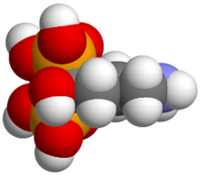Alendronate
From Proteopedia
Alendronate (Fosamax) is commonly known for its use in treatment and prevention of osteoporosis in postmenopausal women and men, but is also used to treat Paget's disease (disease that results in deformed and enlarged bones).[1] Alendronate belongs to the class of nitrogen-containing bisphosphonates, which are inorganic pyrophosphate analogues.Contents |
History of Bisphosphonates
Bisphosphonates were first synthesized in Germany in 1865, but were not studied biologically until 1968. In the interim time, they were used in the textile and fertilizer industries due to their apparent inhibitory effect on calcium carbonate. However, in 1968, a group in Switzerland found inorganic pyrophosphates in urine and plasma. In vitro testing of these molecules revealed that they inhibited calcium phosphate precipitation and dissolution, but were destroyed in vivo by phosphatases. These results led to the discovery of bisphosphonates, as they reacted in the prescribed manner.[2]
Sodium alendronate was first marketed in 1994 as Fosamax® by Merck pharmaceutical. In 2008, Merck lost their U.S. patent on alendronate, allowing Barr Pharmaceuticals and Teva Pharmaceuticals USA to begin marketing generic forms of sodium alendronate. Other brand names for the drug include Fosamax+D®, Adronat, Alendros, Arendal, and Onclast.[3]
Structure and General Function
Alendronate is an aminobisphosphonate with a nonhydrolyzable P-C-P. It is structurally similar to IPP, which is pictured further down the page, and thus can bind to FPPS in place of IPP. Alendronate generally affects the activity of osteoclasts in bone. Osteoclasts are responsible for breaking down bone and also for bone resorption (losing bone substance). [5] When alendronate is present, bone resorption is inhibited and bone breakdown is diminished.
Side Effects of Drug
Possible side effects for Fosamax include nausea,stomach pain, constipation, diarrhea, gas, bloating or fullness in the stomach, change in ability to taste food, headache, dizziness, and swelling of the joints, hands, or legs. More serious side effects (symptoms requiring doctor involvement) include new or worsening heartburn, difficulty swallowing, pain on swallowing, chest pain, bloody vomit or vomit that looks like coffee grounds, black, tarry, or bloody stools, fever, blisters or peeling skin, rash (may be made worse by sunlight), itching, hives, swelling of eyes, face, lips, tongue, or throat, difficulty breathing, hoarseness, painful or swollen gums, loosening of the teeth, numbness or heavy feeling in the jaw, poor healing of the jaw, and eye pain.[6]
Fosamax has also been linked to sudden subtrochanteric and diaphyseal femur fractures, osteonecrosis of the jaw, and esophageal disorders.[7]
Target Proteins and Bone
Alendronate not only targets several proteins, but also directly binds to a bone mineral (hydroxyapatite), which causes the inhibition of bone resorption. The alendronate is bound to hydroxypatite and taken up into the osteoclsat during bone resorption.[8][9]
Protein-Tyrosine-Phosphatases (PTP)
Protein-Tyrosine-Phosphatses (PTPs) are reported to have an effect on osteoclast formation and function. Initial reports indicated that alendronate inhibited several types of PTPs, though specific mechanisms are not known. The data does suggest that alendronate works as an antagonist, which means that, when bound, the alendronate does not elicit a response from the protein but rather disallows the binding of an agonist which would cause a change (likely activating) in the protein.[10][11][12] A is given, so the binding site can be seen.
|
Farnesyl Pyrophosphate Synthase (FPPS)
is considered the main target protein of aminobisphosphonates (including alendronate). FPPS is the prenyl transferase in the HMG-CoA Reductase Pathway, which forms cholesterol (sterols and terpenoids) from acetyl CoA. It reacts with 3-isopentenyl pyrophosphate (IPP) to form geranyl pyrophosphate (GGP). Researchers discovered that alendronate inhibits FPPS because they found a build-up of IPP in the cell, but less GGP.[13]
The FPPS mechanism can be seen below:

The identified mechanism of alendronate on FPPS begins with the absorption of the alendronate into the osteoclast via binding to hydroxyapatite. Once in the osteoclast, the to the active site of FPPS.[14] In the active site, it appears that the alendronate interacts directly with , not allowing the IPP to bind, and effectively daectivating FPPS.
The deactivation of FPPS causes a disruption of prenylation in the cell and thus affects various GTPases. For instance, it will incorrectly activate the GTPases Rho, Rac, and Cdc42.[15] The inhibition of post-translational prenylation of Ras is likely to cause cell apoptosis. [16]
FPPS Substrate
Isopentenyl pyrophosphate (IPP) actually binds to and stabilizes the alendronate-FPPS complex, rather than competing with the inhibitor.[18] IPP can be seen in complex with FPPS and zoledronate . (Zoledronate is also an aminobisphosphonate)
Additional Resources
For Additional Resources, See Pharmaceutical Drugs
References
- ↑ http://www.ncbi.nlm.nih.gov/pubmedhealth/PMH0000018/
- ↑ http://www.ncbi.nlm.nih.gov/pmc/articles/PMC138713/?tool=pmcentrez
- ↑ http://www.drugbank.ca/drugs/DB00630
- ↑ Image from: http://pharmacy-and-drugs.com
- ↑ http://www.medterms.com/script/main/art.asp?articlekey=11794
- ↑ http://www.ncbi.nlm.nih.gov/pubmedhealth/PMH0000018/
- ↑ http://fosamax.legalview.info/
- ↑ http://www.ncbi.nlm.nih.gov/pubmed/20209564
- ↑ http://www.ncbi.nlm.nih.gov/pubmed/16046206
- ↑ http://www.drugbank.ca/drugs/DB00630
- ↑ http://www.ncbi.nlm.nih.gov/pubmed/8610169
- ↑ http://www.ncbi.nlm.nih.gov/pubmed/9310349
- ↑ http://www.ncbi.nlm.nih.gov/pubmed/10620343
- ↑ Fisher et. all. Alendronate mechanism of action: geranylgeraniol, an intermediate in the mevalonate pathway, prevents inhibition of osteoclast formation, bone resorption, and kinase activation in vitro.Cell Biology, Vol. 96, pp. 133–138, January 1999
- ↑ http://www.ncbi.nlm.nih.gov/pubmed/16734383
- ↑ http://www.ncbi.nlm.nih.gov/pubmed/9556058
- ↑ Image from: http://reference.findtarget.com
- ↑ http://www.rcsb.org/pdb/explore/explore.do?structureId=2F92



